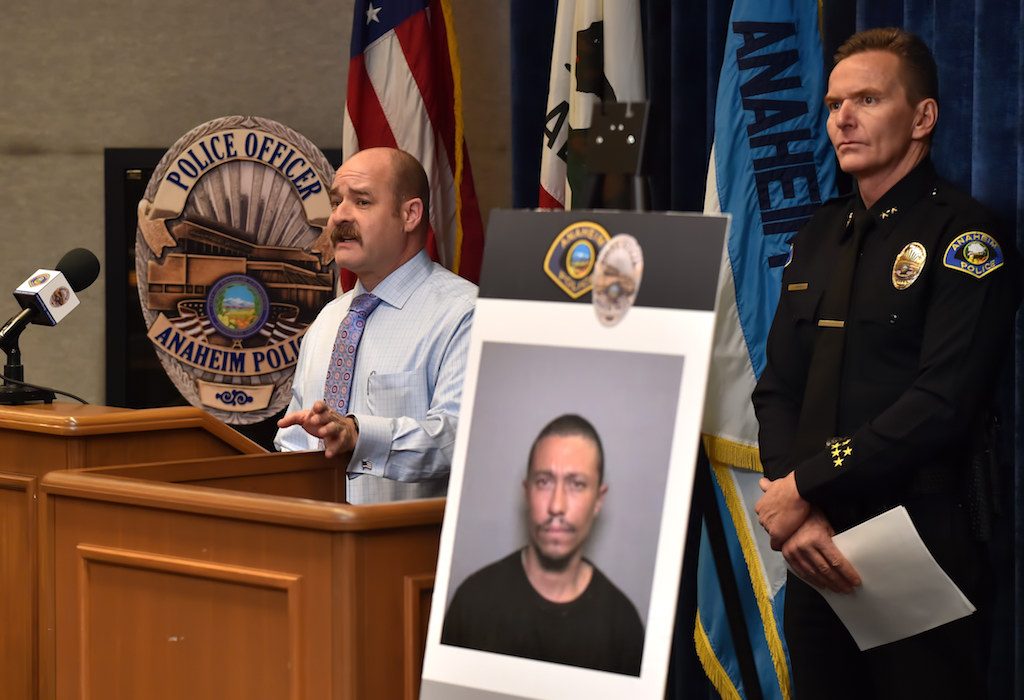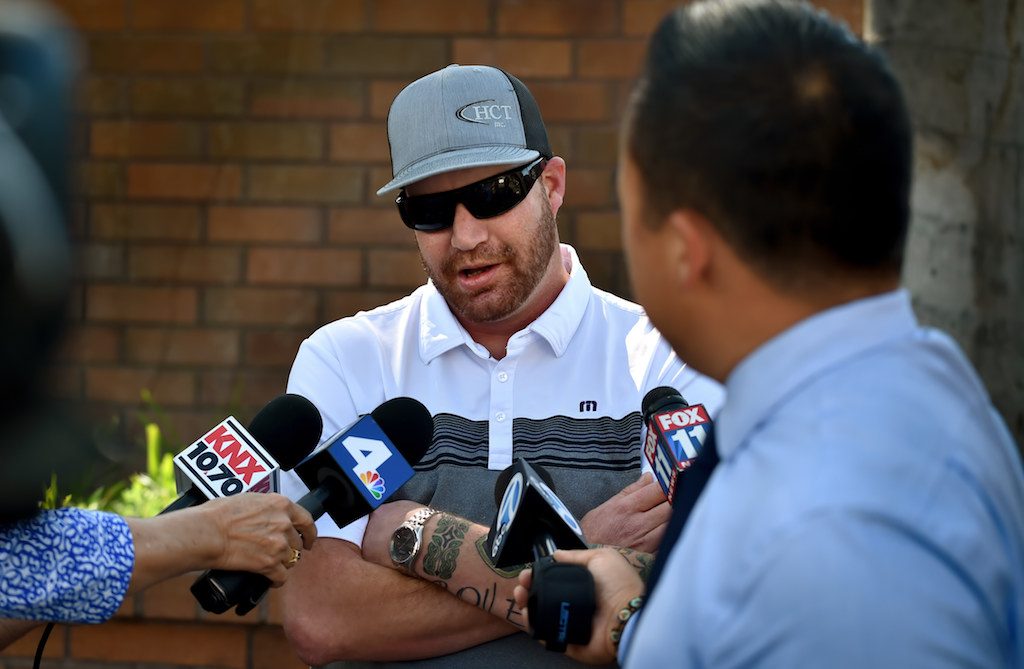An initial review of body-worn camera footage from a March 2 arrest of a residential burglary suspect shows officers followed policy and demonstrated “tremendous restraint,” Anaheim Police Department Acting Chief Julian Harvey said Thursday.
Harvey made the comments at a March 8 news conference at Anaheim Police headquarters to address the suspect’s post-arrest hospitalization and social media speculation about it.
Christopher Eisinger, 35, is hospitalized in serious condition with facial cuts and cerebral edema, or brain swelling.
“First and foremost, our thoughts are with the Eisinger family,” Harvey said. “But the narrative being pushed out on social media is inaccurate and must be corrected.”
A Facebook post by someone describing himself as a childhood friend of Eisinger claimed officers beat the suspect into a coma, comparing the arrest to the 1991 Rodney King incident.

Several media outlets cover the Anaheim PD’s news conference on Thursday, March 8 at APD headquarters. Photo by Steven Georges/Behind the Badge OC
There is no evidence in the officers’ videos showing excessive use of force or to explain Eisinger’s injuries, Harvey said. Eisinger had been hospitalized within a few weeks of his March 2 arrest for injuries sustained in an altercation elsewhere, according to Anaheim Police.
Anaheim officers “handled this very challenging situation professionally,” Harvey said, adding that he saw no punches, baton strikes or Taser use in the video. “We frankly do not know at this time how Mr. Eisinger obtained the injuries he suffered.”
At Acting Chief Harvey’s request, the Orange County District Attorney’s Office is reviewing the arrest of Eisinger, whom Anaheim Police reported as a transient with prior arrests for domestic violence, resisting arrest, threatening an officer, battery on an officer and narcotics violations.
Harvey said it was too early in the investigation to release the body-worn camera footage, which is likely to be released as part of the District Attorney’s review.
“It would be premature,” Harvey said. “There is a protocol that Orange County has established … that these recordings are released by the DA’s office upon the conclusion of their investigative process. We’re going to follow those protocols.”
At least five APD officers, including a supervising sergeant, responded to the call just after midnight on March 2 to a home in the 1300 block of South East Gates Street. A woman in fear called 911 to report a man in her backyard at the rear door who then jumped a fence and tried to break into her cars parked in the front.
“Oh my God, he scared me so bad!” she told an APD dispatcher, according to transcript excerpts of the 911 call, which excluded identifying information about the caller.

Anaheim PD Sgt. Daron Wyatt, left, starts the news conference concerning the March 2 arrest of Christopher Eisinger, 35, before turning the podium over to Acting Chief of Police Julian Harvey, right.
Photo by Steven Georges/Behind the Badge OC
The patrol sergeant was the first to arrive on the scene and saw the suspect in the victim’s driveway, according to an account of the arrest provided by Harvey, as well as an APD news release.
Eisinger refused the sergeant’s command, dropped a large stick or pole and started running away, Harvey said.
Several officers chased him on foot to the 3000 block of West Ball Road. Eisinger tripped and fell, allowing the officers to catch up with him and try to take him into custody.
But Eisinger resisted the officers by “kicking at the officers and moving his arms away from them,” Harvey said. Eisinger showed symptoms of being under the influence of narcotics, Harvey added. At one point, Eisinger tried to take an officer’s Taser and grabbed for another officer’s holster, Harvey said.

Matt Legault, a friend from Lakewood of attempted burglary suspect Christopher Eisinger, stands outside Anaheim Police headquarters to talk to the media about his friend.
Photo by Steven Georges/Behind the Badge OC
Officers used control holds and physical force to stop Eisinger from resisting, but a preliminary investigation indicates that at no time did officers employ the use of a carotid restraint, Taser, impact weapon or deliver any strikes to the suspect.
A carotid restraint temporarily restricts blood flow to the brain and renders a person unconscious, allowing officers to take control. A control hold involves restraining a suspect’s arms and/or legs to subdue him or her.
APD officers were able to handcuff Eisinger after he stopped yelling and “became a little less rigid,” Harvey said.
Eisinger lost consciousness and paramedics were summoned as officers monitored his vital signs.
After paramedics arrived, Eisinger stopped breathing and went into full cardiac arrest. Resuscitation efforts were successful and he was transported to a hospital.
APD investigators followed up on his condition later in the morning of his arrest and were told his condition had not changed and that he was stable. On March 6, the APD was notified that Eisinger’s condition had worsened and that he was being treated for cerebral edema.
Because of the seriousness of Eisinger’s condition, Harvey said he notified the District Attorney to launch an investigation. In addition, the APD initiated its in-house Major Incident Review, or MIRT, process.
Harvey said the incident was the first contact his officers have had with Eisinger, who the APD has determined had attempted to break into at least one residence, as well as vehicles, the night of the arrest.
Eisinger also was found to be in possession of narcotics paraphernalia and showed signs of being under the influence of drugs, the APD said.
Harvey said the APD is one of the most transparent police agencies anywhere, citing it as the first agency in Orange County to deploy body-worn cameras. He also said the APD’s major incident review process now is a model throughout California.
“The men and women of the APD take use of force very seriously…and the APD scrutinizes all uses of force through a very rigorous review process,” Harvey said.
Matt Legault, who described himself as a longtime friend of Eisinger who grew up with him in Lakewood, talked to reporters outside the APD after the news conference.
Legault told reporters he wasn’t questioning the APD’s version of the arrest but that he wished the body-worn camera footage had been released so he could see for himself what happened.
The encounter caught on the APD officers’ born-worn cameras, from the beginning of the chase to when Eisinger was handcuffed, lasted five to six minutes, Harvey said.
He said the quality of video footage he reviewed wasn’t “perfect,” with some of the shots obscured by officers engaging with Eisinger in close proximity.
A reporter asked Harvey if it’s possible the injuries Eisinger sustained may have been caused by blows not captured by the born-worn cameras.
“It’s possible,” Harvey said, “and that’s the reason for these investigations.”
But Harvey reiterated that based on his review of the footage of the arrest, officers acted responsibly based on their training and department policy with no indication of life-threatening force.
 Behind the Badge
Behind the Badge




